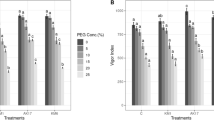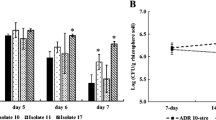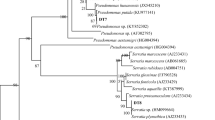Abstract
Drought is the prime abiotic stress that rigorously influences plant growth, yield and quality of crops. The current investigation illustrated the bio-protective characters of Serratia marcescens and Pseudomonas sp. to ameliorate drought stress tolerance, plant growth and nutrient status of wheat. The present study aimed for search of potential drought tolerant plant growth-promoting rhizobacteria (PGPR). All screened bacterial isolates exhibited potential plant growth promoting (PGP) attributes such as production of ACC deaminase, exo-polysaccharide, siderophore, ammonia, IAA, and efficiently solubilized zinc and phosphate under in vitro conditions. To assess the in situ plant growth promotion potential of PGPR, a greenhouse experiment was conducted by priming wheat seeds with screened plant PGPR. Improved water status, reactive oxygen species, osmolyte accumulation, chlorophyll and carotenoids content in plant leaves confirmed the excellent drought tolerance conferring ability of RRN II 2 and RRC I 5. Among all PGPR, RRN II 2 and RRC I 5 inoculated plants not only demonstrated greater harvest index but also exhibited more micronutrient (zinc and iron) content in wheat grains. Further, RRN II 2 and RRC I 5 were identified through 16S rDNA sequencing as S. marcescens and Pseudomonas sp., respectively. Furthermore, amplification of acdS gene (Amplified band size of acdS gene was ~ 1.8 Kb) also confirmed ACC deaminase enzyme producing ability of Pseudomonas sp. Moreover, correlation coefficient, principal component analysis and cluster analysis also demonstrated that nutrient status and values of agronomical parameters of wheat primed with S. marcescens and Pseudomonas sp. were at par with the positive control. Thus, the outcome of this comparative investigation indicates that Pseudomonas sp. and S. marcescens could be utilized as bioinoculant in wheat since they can improve the physiological status, productivity and nutrient status in wheat crop under drought.




Similar content being viewed by others
References
Abd El-Ghani MM, Huerta-Martínez FM, Hongyan L, Qureshi R (2017) Arid deserts of the world: origin distribution and features. In: AbdEl-Ghani MM, Huerta-Martínez FM, Hongyan L, Qureshi R (eds) Plant responses to hyperarid desert environments, 1st edn. Springer, Cham, pp 1–7
Abdelaal K, AlKahtani M, Attia K, Hafez Y, Király L, Künstler A (2021) The role of plant growth-promoting bacteria in alleviating the adverse effects of drought on plants. Biology 10(6):520
Ali SZ, Sandhya V, Rao LV (2014) Isolation and characterization of drought-tolerant ACC deaminase and exopolysaccharide-producing fluorescent Pseudomonas spp. Ann Microbiol 64(2):493–502
Aneja KR (2003) Experiments in microbiology, plant pathology and biotechnology. New Age International, New Delhi
Arshad M, Sharoona B, Mahmood T (2008) Inoculation with Pseudomonas spp containing ACC deaminase partially eliminate the effects of drought stress on growth, yield and ripening of pea (P. sativum L.). Pedosphere 18:611–662
Bakker AW, Schippers B (1987) Microbial cyanide production in the rhizosphere in relation to potato yield reduction and Pseudomonas spp mediated plant growth-stimulation. Soil Biol Biochem 19:451–457
Bazzicalupo M, Fani R (1995) The use of RAPD for generating specific DNA probes for microorganisms. In: Clapp JP (ed) Methods in molecular biology. Humana, Totowa, pp 155–175
Bergey DH (1994) Bergey’s manual of determinative bacteriology, 9th edn. Lippincott Williams & Wilkins, Philadelphia
Bradford MM (1976) A rapid and sensitive method for the quantitation of microgram quantities of protein utilizing the principle of protein-dye binding. Anal Biochem 72(1–2):248–254
Brennan RF (2005) Zinc application and its availability to plants. Ph. D. dissertation, School of Environmental Science, Division of Science and Engineering, Murdoch University
Bric JM, Bostock RM, Silverstone SE (1991) Rapid in situ assay for indoleacetic-acid production by bacteria immobilized on a nitrocellulose membrane. Appl Environ Microb 57:535–538
Caiola MG, Billi D, Friedmann EI (1996) Effect of desiccation on envelopes of the cyanobacterium Chroococcidiopsis sp(Chroococcales). Eur J Phycol 31(1):97–105
Cappuccino JC, Sherman N (1992) Microbiology: a laboratory manual, 3rd edn. Benjamin/Cummings Publishing Company, New York, pp 125–179
Cappuccino JG, Sherman N (2002) Microbiology: a laboratory manual 6th edition. Pearson Education Inc, San Francisco, pp 15–224
Dimkpa C, Weinand T, Asch F (2009) Plant–rhizobacteria interactions alleviate abiotic stress conditions. Plant Cell Environ 32(12):1682–1694
Dworkin M, Foster J (1958) Experiments with some microorganisms which utilize ethane and hydrogen. J bacteriol 75(5):592–603
Emmerich WE, Hardegree SP (1990) Effect of polyethylene glycol exclusion on the water potential of solution-saturated filter paper. Plant Physiol 92(2):462–466
Farajzadeh D, Aliasgharzad N, Bashir NS, Yakhchali B (2010) Cloning and characterization of a plasmid encoded ACC deaminase from an indigenous Pseudomonas fluorescens FY32. Curr Microbiol 61(1):37–43
Food and Agriculture Organization, International Fund for Agricultural Development, World Food Program (2015) The state of food insecurity in the world. strengthening the enabling environment for food security and nutrition. FAO, Rome. http://www.fao.org/3/a4ef2d16-70a7-460a-a9ac-2a65a533269a/i4646e.pdf
Ghorbanpour M, Hatami M, Khavazi K (2013) Role of plant growth promoting rhizobacteria on antioxidant enzyme activities and tropane alkaloid production of Hyoscyamusniger under water deficit stress. Turkish J Biol 37(3):350–360
Glick BR, Todorovic B, Czarny J, Cheng Z, Duan J, McConkey B (2007) Promotion of plant growth by bacterial ACC deaminase. Crit Rev Plant Sci 26(5–6):227–242
Gordon SA, Weber RP (1951) Colorimetric estimation of indole-acetic acid. Plant Physiol 26:192–195
Grichko VP, Glick BR (2001) Amelioration of flooding stress by ACC deaminase-containing plant growth-promoting bacteria. Plant Physiol Biochem 39(1):11–17
Grover M, Ali SZ, Sandhya V, Rasul A, Venkateswarlu B (2010) Role of microorganisms in adaptation of agriculture crops to abiotic stresses. World J Microbiol Biotechnol 27:1231–1240
Gururani MA, Upadhyaya CP, Baskar V, Venkatesh J, Nookaraju A, Park SW (2013) Plant growth-promoting rhizobacteria enhance abiotic stress tolerance in Solanum tuberosum through inducing changes in the expression of ROS-scavenging enzymes and improved photosynthetic performance. J Plant Growth Regu 32(2):245–258
Hajiboland R, Amirazad F (2010) Growth, photosynthesis and antioxidant defense system in Zn-deficient red cabbage plants. Plant Soil Environ 56(5):209–217
Hankin L, Anagnostakis SL (1975) The use of solid media for detection of enzyme production by fungi. Mycologia 67:597–607
Hasanuzzaman M, Nahar K, Gill SS, Fujita M (2013) Drought stress responses in plants, oxidative stress, and antioxidant defense. Climate change and plant abiotic stress tolerance. Wiley-VCH Verlag GmbH & Co. KGaA, Weinheim, pp 209–250
Hassanein AM (2010) Establishment of efficient in vitro method for drought tolerance evaluation in Pelargonium. J Hortic Sci Ornam Plants 2(1):8–15
Hiscox JT, Israelstam GF (1979) A method for the extraction of chlorophyll from leaf tissue without maceration. Can J Bot 57(12):1332–1334
Honma M, Shimomura T (1978) Metabolism of 1-aminocyclopropane-1-carboxylic acid. Agric Biol Chem 42(10):1825–1831
Huang B, DaCosta M, Jiang Y (2014) Research advances in mechanisms of turfgrasstolerance to abiotic stresses: from physiology to molecular biology. Crit Rev Plant Sci 33(2–3):141–189
Hussain MB, Mahmood SAJID, Ahmed NIAZ, Nawaz H (2018) Rhizobial inoculation for improving growth physiology nutrition and yield of maize under drought stress conditions. Pak J Bot 50(5):1681–1689
Jaleel CA, Manivannan P, Sankar B, Kishorekumar A, Gopi R, Somasundaram R, Panneerselvam R (2007) Pseudomonas fluorescens enhances biomass yield and ajmalicine production in Catharanthusroseus under water deficit stress. Colloids Surf B 60:7–11
Jin J, Wang G, Liu X, Pan X, Herbert SJ, Tang C (2006) Interaction between phosphorus nutrition and drought on grain yield, and assimilation of phosphorus and nitrogen in two soybean cultivars differing in protein concentration in grains. J Plant Nut 29(8):1433–1449
Joshi D, Negi G, Vaid S, Sharma A (2013) Enhancement of wheat growth and Zn content in grains by zinc solubilizing bacteria. Int J Agric Environ Biotechnol 6:363–370
Kasana RC, Salwan R, Dhar H, Dutt S, Gulati A (2008) A rapid and easy method for the detection of microbial cellulases on agar plates using Gram’s iodine. Curr Microbiol 57(5):503–507
Khan A, Singh J, Upadhayay VK, Singh AV, Shah S (2019) Microbial biofortification: a green technology through plant growth promoting microorganisms. In: Shah S, Venkatramanan V, Prasad R (eds) Sustainable green technologies for environmental management, 1st edn. Springer, Singapore, pp 255–269
Kirk JTO, Allen RL (1965) Dependence of chloroplast pigment synthesis on protein synthesis: effect of actidione. Biochem Biophys Res Communs 21(6):523–530
Kour D, Rana KL, Yadav AN, Yadav N, Kumar V, Kumar A, Sayyed RZ, Hesham AE, Dhaliwal HS, Saxena AK (2019) Drought-tolerant phosphorus-solubilizing microbes: biodiversity and biotechnological applications for alleviation of drought stress in plants. Plant growth promoting rhizobacteria for sustainable stress management. Springer, Singapore, pp 255–308
Kramer PJ, Boyer JS (1995) Water relations of plants and soils. American Academic Press, Cambridge
Lau JA, Lennon JT (2012) Rapid responses of soil microorganisms improve plant fitness in novel environments. Proc Natl Acad Sci USA 109:14058–14062
Mateos PF, Jimenez-Zurdo JI, Chen J, Squartini AS, Haack SK, Martinez-Molina E, Hubbell DH, Dazzo FB (1992) Cell-associated pectinolytic and cellulolytic enzymes in Rhizobium leguminosarum biovar trifolii. Appl Environ Microbiol 58(6):1816–1822
Naylor D, Coleman-Derr D (2018) Drought stress and root-associated bacterial communities. Front Plant Sci 8:2223
Nisha R, Kaushik A, Kaushik CP (2007) Effect of indigenous cyanobacterial application on structural stability and productivity of an organically poor semi-arid soil. Geoderma 138(1–2):49–56
Niu X, Song L, Xiao Y, Ge W (2018) Drought-tolerant plant growth-promoting rhizobacteria associated with foxtail millet in a semi-arid agroecosystem and their potential in alleviating drought stress. Front Microbiol 8:2580
Osakabe Y, Osakabe K, Shinozaki K, Tran LSP (2014) Response of plants to water stress. Front Plant Sci 5:86
Payne SM (1994) [25] detection, isolation, and characterization of siderophores. Methods Enzymol 235:329
Pikovskaya RI (1948) Mobilization of phosphorus in soil in connection with vital activity of some microbial species. Mikrobiologiya 17:362–370
Ramesh A, Sharma SK, Sharma MP, Yadav N, Joshi OP (2014) Inoculation of zinc solubilizing Bacillus aryabhattai strains for improved growth, mobilization and biofortification of zinc in soybean and wheat cultivated in Vertisols of central India. Appl Soil Ecol 73:87–96
Sambrook J, Russel DW (2001) Molecular cloning–A laboratory manual 3rd edn. Cold Spring Harbor Laboratory Press, Cold Spring Harbor, NY, p 2344
Sankar B, Jaleel CA, Manivannan P, Kishorekumar A, Somasundaram R, Panneerselvam R (2007) Drought-induced biochemical modifications and proline metabolism in Abelmoschus esculentus (L.) Moench. Acta Bot Croat 66(1):43–56
Saravanan VS, Subramoniam SR, Raj SA (2003) Assessing in vitro solubilization potential of different zinc solubilizing bacterial (ZSB) isolates. Braz J Microbiol 34:121–125
Sarma RK, Saikia R (2014) Alleviation of drought stress in mung bean by strain Pseudomonas aeruginosa GGRJ21. Plant Soil 377:111–126
Schwyn B, Neilands JB (1987) Universal chemical assay for the detection and determination of siderophores. Anal Biochem 160(1):47–56
Sharma R, Manda R, Gupta S, Kumar S, Kumar V (2013) Isolation and characterization of osmotolerant bacteria from Thar Desert of Western Rajasthan (India). Rev Biol Trop 61(4):1551–1562
Singh RP, Jha PN (2016) The multifarious PGPR Serratia marcescens CDP-13 augments induced systemic resistance and enhanced salinity tolerance of wheat (Triticum aestivum L.). PLoS ONE 11(6):e0155026
Singh AV, Prasad B, Shah S (2010) Screening plant growth promontory rhizobacteria for improving seed germination and seedling vigor of lentil (Lens culinaris Medik). Environ Ecol 30(3B):2055–2058
Singh AV, Chandra R, Goel R (2012a) Phosphate solubilization by Chryseobacterium sp. and their combined effect with N and P fertilizers on plant growth promotion. Arch Agron Soil Sci 59:641–651
Singh AV, Sharma A, Johri BN (2012b) Phylogenetic profiling of culturable bacteria associated with early phase of mushroom composting assessed by amplified rDNA restriction analysis. Ann Microbiol 62(2):675–682
Suyal DC, Yadav A, Shouche Y, Goel R (2014) Differential proteomics in response to low temperature diazotrophy of Himalayan psychrophilic nitrogen fixing Pseudomonas migulae S10724 strain. Curr Microbiol 68:543–550
Thomas-Edison E, Martin DCJ, Torres O (2012) Gelatin hydrolysis test protocol library. http://www.Microbelibrary.org/Library/Laboratorytest/
Vijayabaskar P, Babinastarlin S, Shankar T, Sivakumar T, Anandapandian KTK (2011) Quantification and characterization of exopolysaccharides from Bacillus subtilis (MTCC 121). Adv Biol Res 5:71–76
Vinocur B, Altman A (2005) Recent advances in engineering plant tolerance to abiotic stress: achievements and limitations. Curr Opin Biotechnol 16:1–10
Vurukonda SSKP, Vardharajula S, Shrivastava M, SkZ A (2016) Enhancement of drought stress tolerance in crops by plant growth promoting rhizobacteria. Microbiol Res 184:13–24
Weatherley P (1950) Studies in the water relations of the cotton plant: I The field measurement of water deficits in leaves. New Phytol 49(1):81–97
Wilson K, Walker J (2010) Principles and techniques of biochemistry and molecular biology. Cambridge University Press, Cambridge
Yang J, Kloepper JW, Ryu CM (2009) Rhizosphere bacteria help plants tolerate abiotic stress. Trends Plant Sci 14(1):1–4
Zahir ZA, Ghani U, Naveed M, Nadeem SM, Asghar HN (2009) Comparative effectiveness of Pseudomonas and Serratia sp. containing ACC-deaminase for improving growth and yield of wheat (Triticum aestivum L.) under salt-stressed conditions. Arch Microbiol 191(5):415–424
Zhang M, Yang L, Hao R, Bai X, Wang Y, Yu X (2020) Drought-tolerant plant growth-promoting rhizobacteria isolated from jujube (Ziziphus jujuba) and their potential to enhance drought tolerance. Plant Soil. https://doi.org/10.1007/s11104-020-04582-5
Zhao FJ, Su YH, Dunham SJ, Rakszegi M, Bedo Z, McGrath SP, Shewry PR (2009) Variation in mineral micronutrient concentrations in grain of wheat lines of diverse origin. J Cereal Sci 49:290–295
Funding
Not applicable.
Author information
Authors and Affiliations
Contributions
AK performed research, analyze data and written manuscript; editing of the manuscript and research carried out under the guidance of AVS.
Corresponding author
Ethics declarations
Conflict of interest
The author declares no conflict of interest.
Additional information
Publisher's Note
Springer Nature remains neutral with regard to jurisdictional claims in published maps and institutional affiliations.
Supplementary Information
Below is the link to the electronic supplementary material.
Rights and permissions
About this article
Cite this article
Khan, A., Singh, A.V. Multifarious effect of ACC deaminase and EPS producing Pseudomonas sp. and Serratia marcescens to augment drought stress tolerance and nutrient status of wheat. World J Microbiol Biotechnol 37, 198 (2021). https://doi.org/10.1007/s11274-021-03166-4
Received:
Accepted:
Published:
DOI: https://doi.org/10.1007/s11274-021-03166-4




